following the near-disaster on the nakasendo, it was clear that in order to keep up this trip i'd have to make a pit stop in tokyo sooner rather than later in order to shed the additional pack weight i'd picked up along my journey. though i could always get to tokyo by going back down the nakasendo in the opposite direction, i was now within close proximity of another historic road leading back to tokyo: the tokaido. it was the nakasendo's coastal counterpart, running from tokyo to kyoto down the eastern coast instead of through the mountains, the most important and heavily-trafficked of all the edo period roads, probably because it runs along nice flat coastal plains and doesn't require traversing any treacherous passesi had to wonder, why did anyone take the nakasendo? i looked into it and it seems that there were some that preferred to avoid the river fords along the tokaido, the nakasendo was also considered in some ways "the scenic route".. these days the tokaido still enjoys much better name recognition than the nakasendo, mainly because it lends its name to the tokaido shinkansen that roughly parallels its former route.
obviously i wasn't in a hurry to start walking japan’s historic roads again immediately following the Magome Pass Incident (2025), but i also wasn’t in such a hurry that i wanted to zip back up on the tokaido shinkansen in about an hour and a half. at times the shinkansen is almost too fast, you don't really get an appreciation for how far you've gone, there's no time to properly savor the landscape or the ride, no time to get really deep into reading or writing something. because of that, even when i had been in a hurry getting back to tokyo to deal with my bags a week or two before, i deliberately took the slowest "kodama" service that stops at every station..
the shinkansen is not the only rail option following the old tokaido, however. there is still a conventional rail line built before the shinkansen that runs along the entire route, the Tokaido Main Line. it is now used primarily for local trains, no one train runs along the whole line, at their furthest services run only from one major city to the next, though if you have the patience you can transfer at each major city and "hop" your way back to tokyo using only local trains. that is in fact exactly what i decided to do, except i planned on taking it even slower by staying a night in each of those major cities, riding only one local train for 1-2 hours a day to get to my next "post town" on the tokaido. i had no idea whatsoever what there was to do in any of those cities, but it didn't matter because i didn't even really want to do anything, after all the excitement on the nakasendo i just wanted to take it easy for a while and chip away at the writing backlog some more...
prologue: inuyama
ok, so this isn't technically on the tokaido yet, but i absolutely have to bring it up somewhere. inuyama is one of the furthest north outlying cities of the nagoya metropolitan area ("chūkyō"), not too far from where the nakasendo emerges from the kiso valley and thus a convenient place to book a post-trail hotel. however, i had ulterior motives too, in fact part of the reason i decided to go down the nakasendo after matsumoto was because i would end up near inuyama, where i would have another chance for redemption. you see, inuyama is home to the museum meiji-mura, though it's called a museum and does indeed preserve a wide variety of historic japanese buildings from the namesake era and later, in practice it is also possibly the world's only architecture-themed theme park. that alone is already enough to attract my interest, but why i desperately wanted to go was because of its headliner attraction: the preserved lobby of frank lloyd wright's imperial hotel, designed in the very rare and exquisite mayan revival style. the hotel was demolished in 1967 (which i once called "the greatest architectural crime of the 20th century") and i had given up hope of ever experiencing it in person, then a couple years ago i discovered part of it had actually been preserved in a quirky museum/theme park in the far outskirts of nagoya and i've been obsessed with trying to visit it ever since.
unfortunately, my first attempt was foiled by an unprecedented catastrophe: a japanese train arriving late. to be fair, it was only by ten minutes (fun fact: amtrak still considers trains to have arrived "on time" if they arrive within 30 minutes of their scheduled time), but that was enough for me to miss my connection in nagoya and the next train left too late for it to be worth going that day. i decided i'd stay the night in nagoya (i found a wonderful cheap APA in central nagoya that even had an included rooftop bath) and try to go the next day. that evening in the hotel, i looked up their hours online to do a little planning and discovered that starting the next day, they were going to be closed for basically the entire first half of the month so i gave up and took the shinkansen back to tokyo the next day...
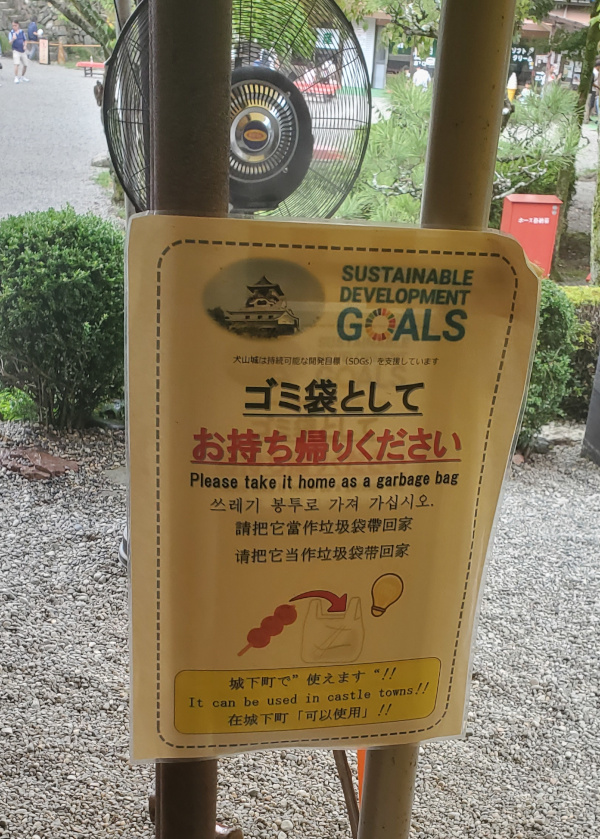 inuyama castle also gets a shoutout for having the most absurd SDG bullshit i've ever seen, a sign at the exit saying you should take home the bag used to store your shoes and use it as a garbage bag, or perhaps reuse it when you take off your shoes at the next castle you visit. out of the hundreds of people i watched exit, i did actually see one person take the bag with them...then of course on the same day i planned on going to meiji-mura i ended up making the biggest tactical mistake of my entire trip and wasted half the day on what was supposed to be a brief detour to check out inuyama castle, the station had a good view of it and it looked kinda neat. anyways, suffice to say that is the LAST time i go inside a japanese castle, i was lured in by the typical japanese "almost free" (like $3) admission price and then discovered there was a huge line to get in because it was the weekend. after standing in the queueing area outside in the sun long enough to get my shirt soaked in sweat as always (approximately 15 minutes), i finally made it to the head of the line just as they stopped letting people in for a while to reduce crowding indoors. i waited there almost as long as i'd waited in the rest of the line as a steady stream of what felt like hundreds of people exited the modest castle keep, continually astounded that they hadn't decided to start letting people in again. at the very least the entrance was shaded and had an actual fan, so it was probably the best place to wait. then finally they let me in and it was the typical lame japanese castle interior experience (i complained about this before: shoes off, climbing treacherously steep narrow stairs that are effectively ladders to visit rooms that are either completely empty or filled with boring dusty museum exhibits), except this one was STUFFED with people, suddenly the staff concerns about overcrowding made total sense to me and i even thought that maybe they should have held up the line longer.
inuyama castle also gets a shoutout for having the most absurd SDG bullshit i've ever seen, a sign at the exit saying you should take home the bag used to store your shoes and use it as a garbage bag, or perhaps reuse it when you take off your shoes at the next castle you visit. out of the hundreds of people i watched exit, i did actually see one person take the bag with them...then of course on the same day i planned on going to meiji-mura i ended up making the biggest tactical mistake of my entire trip and wasted half the day on what was supposed to be a brief detour to check out inuyama castle, the station had a good view of it and it looked kinda neat. anyways, suffice to say that is the LAST time i go inside a japanese castle, i was lured in by the typical japanese "almost free" (like $3) admission price and then discovered there was a huge line to get in because it was the weekend. after standing in the queueing area outside in the sun long enough to get my shirt soaked in sweat as always (approximately 15 minutes), i finally made it to the head of the line just as they stopped letting people in for a while to reduce crowding indoors. i waited there almost as long as i'd waited in the rest of the line as a steady stream of what felt like hundreds of people exited the modest castle keep, continually astounded that they hadn't decided to start letting people in again. at the very least the entrance was shaded and had an actual fan, so it was probably the best place to wait. then finally they let me in and it was the typical lame japanese castle interior experience (i complained about this before: shoes off, climbing treacherously steep narrow stairs that are effectively ladders to visit rooms that are either completely empty or filled with boring dusty museum exhibits), except this one was STUFFED with people, suddenly the staff concerns about overcrowding made total sense to me and i even thought that maybe they should have held up the line longer.
after leaving inuyama castle, i rushed back to the station and got on the bus towards meiji-mura, the bus was completely empty which got me a little concerned that it might be closed again. nope, turns out everyone except me had the good sense to head out to meiji-mura earlier than 3pm... as soon as i got in, i wasted no time in making a beeline for the imperial hotel lobby, conveniently located at the far end of the park...
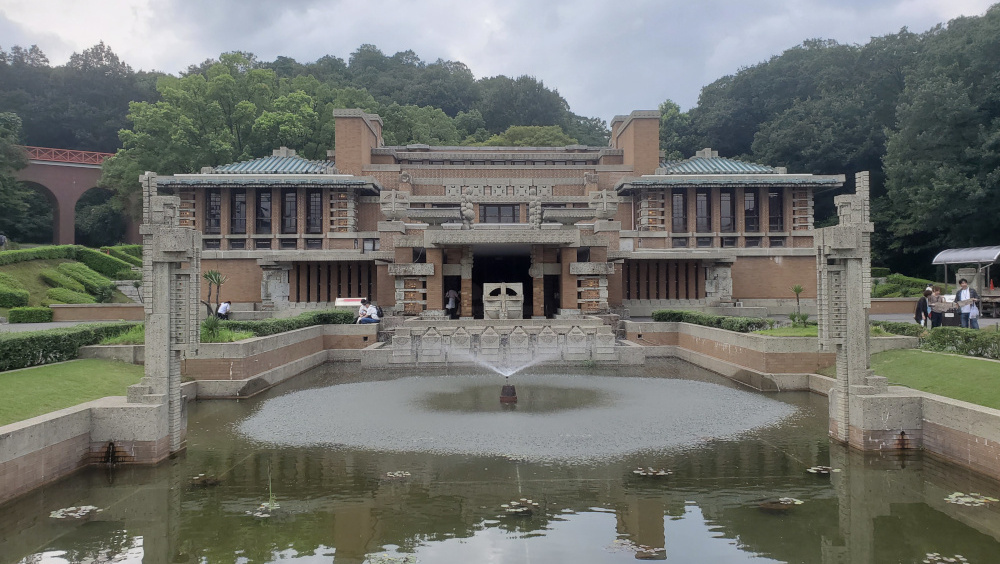
i used up nearly half my remaining time admiring it, then went off on a breakneck tour trying to see as much of the rest of the park before closing as i could. the park consists of a collection of historic buildings (originally mostly western-inspired meiji-era buildings, but now including many different time periods) rescued from demolition during the post-war development boom by relocating them to the "rolling hills" alongside a reservoir near inuyama, all bankrolled by nagoya railroad (better known as "meitetsu"), which still operates the park to this day. it was incredible, even though i was only there for two hours at one of the most expensive admission prices of anywhere i went in japan (2.5k yen) it was worth every yenny, i could easily spend a whole day or more there, i saw a meiji-era prison and photo studio, a catholic church, a vintage post office, an old bathhouse with a single pool split into halves for men and women by only a wooden partition in the middle above the water (IMAGINE bathing in the same water as naked girls one inch of wood away), a japanese meetinghouse from hawaii, natsume soseki's house, an ancient burial mound that was apparently there from before the museum was established, and that wasn't even half of it. i was rushing anyone so fast that once again my shirt got completely soaked in sweat (which got me thinking "i am NEVER coming back to japan in the summer again" for the fiftieth time), even then it feels like i barely scratched the surface, i will have to go back someday...
toyohashi
my first real "post town" on the tokaido was toyohashi, on the coast just southeast of the nagoya area. getting there from inuyama was unexpectedly convenient because there was actually a meitetsu limited express train that let me go all the way between them without transferring, a distance of about 100km, and the good thing about getting on near the terminus is that it was easy to snag a seat for the whole ride. in toyohashi i finally managed to bag a cheap room at a route inn, i'd been wanting to stay at one for a while but they were always too expensive because it's one of the more upscale business hotel chains my main observation about route inn is that they have the cutest mascot of all the business hotels, a sheep named "ruton" (presumably a portmanteau of "route inn" and "mouton", french for "sheep"). i soon found out why it was probably so cheap: toyohashi is the trashiest city i've ever been to in japan. just outside the station i saw my first genuine homeless person of the trip, and in order to get anywhere (including the route inn toyohashi) you had to go through this whole sleazy nightlife district right by the station. maybe i caught it on a particularly bad day because it was the evening before a holiday, but there were many rowdy groups in the streets already ugly drunk at 8-9pm. as i was desperately searching for food after not having eaten almost all day, aggressive touts called out to me from the street corners and then a drunken crew of old schoolmates ("we went to the same... uhhh... junior high school together... we graduated... 17? years ago...") invited me to drink with them, but we drifted apart because they couldn't choose a place and i really needed to go somewhere with proper food.
my main observation about route inn is that they have the cutest mascot of all the business hotels, a sheep named "ruton" (presumably a portmanteau of "route inn" and "mouton", french for "sheep"). i soon found out why it was probably so cheap: toyohashi is the trashiest city i've ever been to in japan. just outside the station i saw my first genuine homeless person of the trip, and in order to get anywhere (including the route inn toyohashi) you had to go through this whole sleazy nightlife district right by the station. maybe i caught it on a particularly bad day because it was the evening before a holiday, but there were many rowdy groups in the streets already ugly drunk at 8-9pm. as i was desperately searching for food after not having eaten almost all day, aggressive touts called out to me from the street corners and then a drunken crew of old schoolmates ("we went to the same... uhhh... junior high school together... we graduated... 17? years ago...") invited me to drink with them, but we drifted apart because they couldn't choose a place and i really needed to go somewhere with proper food.
as far as i could tell, the only thing toyohashi had going for it was that it's the setting for something called 負けヒロインが多すぎる (マケイン for short), big banners featuring the characters were hanging from the roof of the decaying shoutengai. it appears to be one of the current popular flavor-of-the-month romcom haremslop franchises based on a light novel, i looked it up and the two sentence plot summary on wikipedia begins "self-proclaimed 'background character' Kazuhiko Nukumizu...", which led to me reflecting briefly about the fact that the protagonists of those things always seem to be "self-proclaimed background characters". as far as i can tell, it's only set in toyohashi because it's the hometown of the original light novel author.
i suppose it's not very fair to judge a city by just a couple blocks around the main train station... then again, it is kind of representative of a city, if they can't bother to clean up the part of the city most visitors will first encounter, then what must the rest look like? but toyohashi still has some good parts, in the sober light of day i found a convenient book-off by the station and made some additional ill-advised increases to my pack weight, but how was i supposed to turn down a chance to buy the first four volumes of 微熱空間 for 110 yen each after searching for it on a whim?what can i say, i'm going through a phase of aoki umania right now... kinda crazy that the reason hidamari sketch is on hiatus is because she's busy with a "what are you doing stepbro?" manga.... then, on the main street right across from the station on what probably should have been prime real estate, i stumbled upon a shuttered pachinko parlor with the most incredible rooftop ornamentation i've ever seen in japan, a huge model of the space shuttle columbia that was probably installed well before the real one exploded in 2003, not to mention the establishment was apparently named "USA" and also had a wonderful vertical neon sign saying "𝒫𝒜𝒞𝐻𝐼𝒩𝒦𝒪" that reminded me of the "GAMBLING" sign outside binion's on fremont street in vegas. i should buy it and turn it into a rhythm game arcade, with japanese real estate prices and the exchange rate the way it is there's no way it can cost more than i can get maxxing out my credit cards and running away to japan.
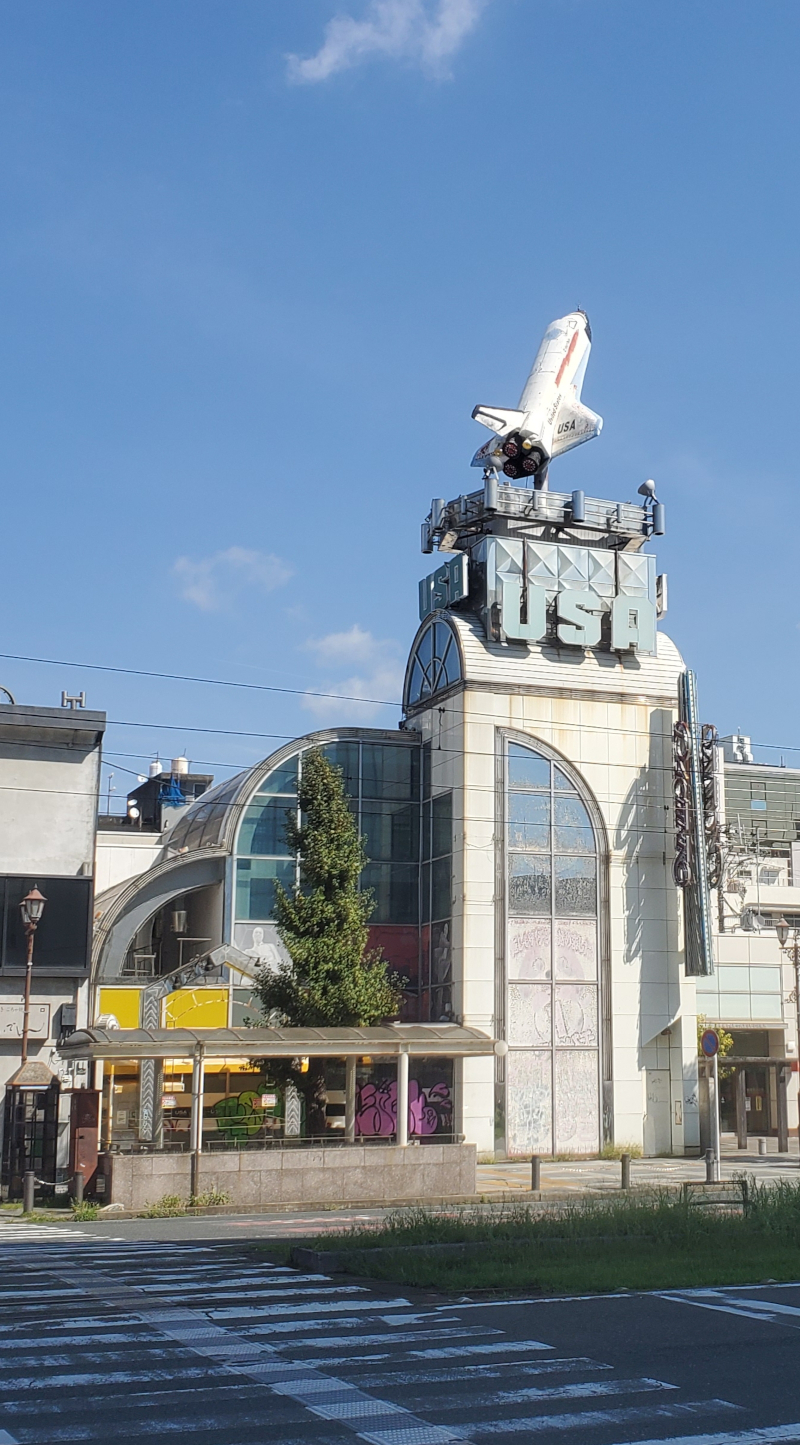
before leaving toyohashi, i posted up in tully's coffee by the station and (you can't make this up) a japanese girl genuinely sat down at the table next to me and spent two hours drawing touhou fanart, a lavish illustration of remilia and flandre...
hamamatsu
you gotta love it when a city has "The Building", and no city has "The Building" more than hamamatsu. The Building doesn't just dominate hamamatsu's skyline, it is the skyline; there are no other buildings in hamamatsu tall enough to be considered skyscrapers.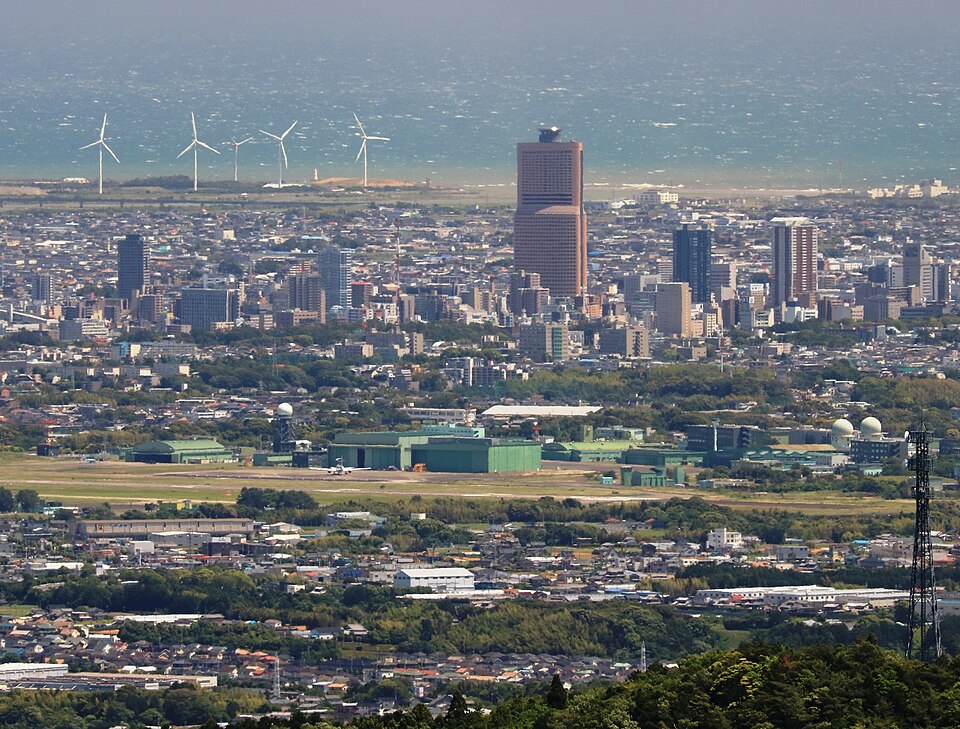 this has seriously got to be one of the world's most ridiculous cityscapes
this has seriously got to be one of the world's most ridiculous cityscapes
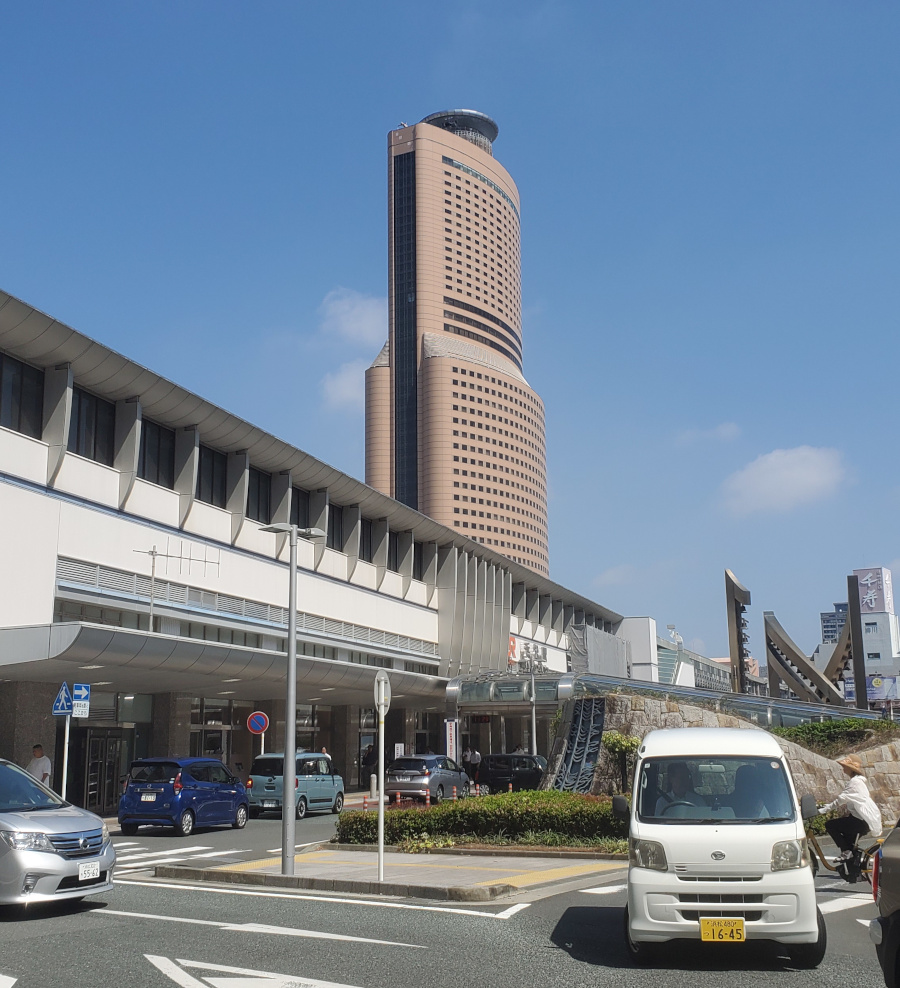
without even trying i somehow managed to stumble upon a lone skyscraper almost as outrageous as phoenix seagaia's Ocean Tower, The Building is tied for 30th tallest in japan and is the only one in the top fifty located outside of japan's three biggest metro areas (tokyo, osaka, and nagoya). at the very least it was built in the middle of a city (unlike ocean tower), though it sits there at the city center so much more massive than its surroundings that it almost seems like the city sprang up around The Building rather than the other way around. it sets the imagination running wild: it seems big enough that a significant proportion of the city could live in it like that one town in alaska where everyone lives in one building, or perhaps it is a grounded spacecraft or other alien remnant (a la Halo), or maybe the tower is a mysterious ancient quasi-natural formation filled with dangerous monsters and powerful artifacts, an inverted abyss (though i will say that delving is definitely more foreboding than climbing).
what could have possibly possessed hamamatsu to build a skyscraper over twice the height of the city's next tallest building? where did they get the money? by now loyal readers should know that there can only be one culprit for such follies, bubble era exuberance. to the expert eye, the bright beige tiled facade and somewhat whimsical postmodern designit's meant to look like a harmonica, as a nod to the city's prominent instrument industry, yamaha (among others) is based in hamamatsu also date The Building quite clearly to the late bubble era of the early nineties, back when it was starting to unravel but big projects initiated at its height were still being slowly completed nonetheless. Act Tower (The Building's government name) was completed in 1994, and like Ocean Tower it was the centerpiece of a whole complex called "Act City" that includes concert halls, shopping and dining, offices, a museum, a hotel, and more. most were housed in the base of The Building, quite expansive in its own right as though it was neccessary to support the weight of the tower, and attracted by the gravitational pull of The Building, that's where i found myself approximately ten minutes after arriving in hamamatsu.
Act City is connected to hamamatsu station by a walkway (or perhaps gangplank), though instead of going inside right away i opted to clamber around the exterior, a complex assemblage of stairways, passages, bridges, ramps, plazas, gardens, courtyards, and squares all attached to the outside of a mass above the rest of the city, it felt like an urban island or ship floating above the sprawling sea of dense tiny little buildings that made up the rest of hamamatsu, like most japanese cities. the exterior spaces were monumental and eerily abandoned, that plus the architectural style gave it the precise vibe of the 1993 video game Myst. although the design looks unquestionably dated now, i cannot say Act City was shabby at all, it was maintained impeccably and kept spotlessly clean, not a single one of the millions of unfashionable beige tiles composing the facade was missing, broken, or even dirty"why do you always sound almost a little disappointed when these places don't turn out to be shabby?".
when i could no longer take the heat, i descended down a striking spiral staircase and then entered The Building at the ground floor. the inside of the building was shockingly normal, there were coffee shops and restaurants and a familymart, the halls were bustling with salarymen going about their business, the innocuous explanation is that nobody was outside because they were busy and it was way too hot. similar to the exterior, the inside was a warren of doors and hallways, only with great effort did i manage to finally find my way to the elevator leading to the 45th floor observation deck. but, then i saw the admission price: 1200 yen (~$7.50), a bit rich for japan, and i decided not to go up. there was no point in going up to the observatory deck anyway, it was the one place in hamamatsu where you couldn't see the only thing i wanted to look at...
shizuoka
the next big city along the tokaido is shizuoka, capital of the namesake prefecture, though hamamatsu is actually the largest city in shizuoka prefecture. in retrospect this blog post maybe should have been called "shizuoka sojourn" or something because most of the coastline between tokyo and nagoya lies within shizuoka prefecture (including the whole peninsula and half of fuji too, shizuoka is pretty stacked), the last section of this post and the next two are all set in it too. despite that, i had no idea what there was to do in the actual city of shizuoka, luckily when i offhandedly mentioned i was on my way there shibs came in clutch with some recommendations.
the first thing he said was that i absolutely MUST try out "sawayaka", a local chain of hamburg-focused family restaurants. this sounded perfect to me because i was on a bizzare personal quest to try and eat as much yoshuku (like hamburg steak) as possible while in japan, to make up for all the tourists that come to japan and only eat ramen and sushifunnily enough, the only time i had ramen in japan was a couple days later when i met up with shibs and we just wanted to get something quick for dinner near his place. i checked into my hotel and headed for the nearby department store with a sawayaka on the top floor right away, even though it was only 4:30 i was already hungry. that ended up being a good call because it's one of those restaurant chains that always seems to have a wait, like komeda's coffee or kura sushi or ichiran (even though everyone claims it isn't that good), but i walked in at the perfect time and got a booth right away. the interior was cozy and homely, like a small-town diner or how many american chains used to be before they got self-conscious and tried to rebrand themselves as slick and modern during the great flattening of the noughties/tennies, stripping away all their character in sterile remodels. 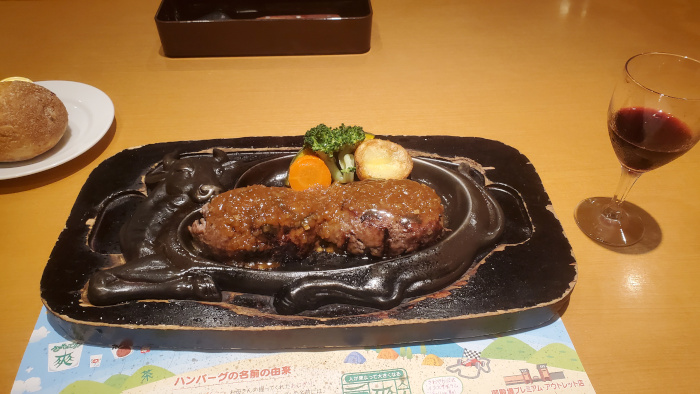 the food was on the pricy side (for japan) but totally worth it, their hamburgs were actually better than that bougie place i went to in tokyo when we were killing time before leaving. it was also one of those meals where serving it involves a whole miniature production at the table: first, long before the main dish comes out, you get a paper place setting printed with a map showing all of sawayaka's locations within shizuoka prefecture, then after a while the waitress comes out with the whole hamburg resting on an elaborate dish with an engraved cow design, when she lays it on the table in front of you it's still violently sizzling so you're supposed to raise the paper place mat as a sort of shield or bib to protect yourself from the leaping juices, then with practiced motions the waitress pulls out an unneccessarily-long carving knife and from a good distance carefully slices your hamburg into a couple more manageable pieces, and finally you're left to wait salivating until the pieces cool to an edible temperature.
the food was on the pricy side (for japan) but totally worth it, their hamburgs were actually better than that bougie place i went to in tokyo when we were killing time before leaving. it was also one of those meals where serving it involves a whole miniature production at the table: first, long before the main dish comes out, you get a paper place setting printed with a map showing all of sawayaka's locations within shizuoka prefecture, then after a while the waitress comes out with the whole hamburg resting on an elaborate dish with an engraved cow design, when she lays it on the table in front of you it's still violently sizzling so you're supposed to raise the paper place mat as a sort of shield or bib to protect yourself from the leaping juices, then with practiced motions the waitress pulls out an unneccessarily-long carving knife and from a good distance carefully slices your hamburg into a couple more manageable pieces, and finally you're left to wait salivating until the pieces cool to an edible temperature.
on leaving the department store, i wandered around downtown shizuoka a bit and stumbled upon yet another surugaya specialty store, how does this always happen? i'm not sure if i've had a chance to bring this up yet, but for a long time now they've been my favorite purveryor of secondhand otaku goods, their prices are reasonable and their selection is only rivalled by the legendary mandarake (RULERS OF TIME™). the little surugaya outlet in front of akihabara station has been the site of many improbable finds (especially on this trip) and through shizuoka i was even still hauling around one of my rare finds from the surugaya in matsumoto. it turns out the surugaya in shizuoka isn't just any surugaya, it's THE surugaya, the flagship store of the whole nationwide chain. i didn't know this beforehand, but surugaya actually originates from and is still headquartered in shizuoka, "suruga" is a historic name for the region, still borne by adjoining bay and by one of the city's three wards (the ending "-ya", meanwhile, just means store or shop). the flagship store was new and shiny, recently opened as part of some hometown reinvestment/revitalization scheme on the part of surugaya, and is quite possibly the largest otaku store under one roof in all of japan, if not the world, i browsed for two hours and somehow miraculously escaped with my wallet unharmed, mainly because i was keenly aware my bag couldn't fit a single additional item at this point.
the store had departments with expansive selections for all the usual otaku fare like figures, retro video games, model kits, trading cards, etc., but also had sections dedicated to more niche interests: a huge area dedicated to trains that even had a track you could bring in and drive your rare model trains on to show off, a section just for pokemon plushes organized according to the in-game type system, an aisle with airsoft and military gear, a touhou corner, a retro PC area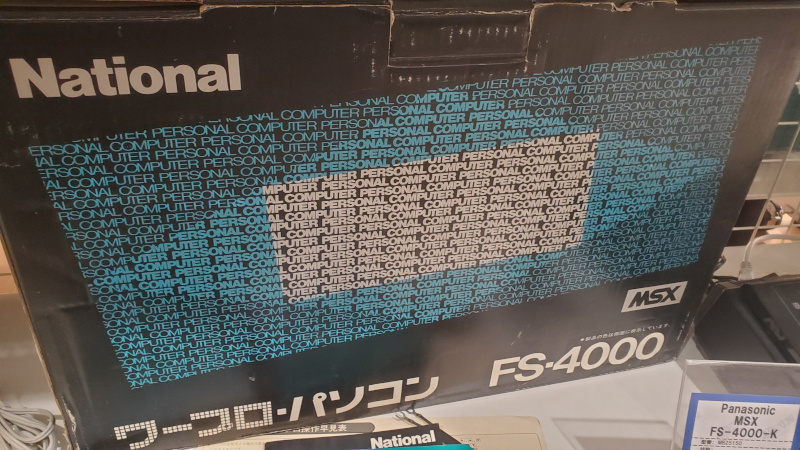 with working displays too, and a department with secondhand small household appliances that some of the larger surugayas tend to include for some reason. they also had a discount "outlet" section with bins where you could rummage through unwanted ichibankuji/gacha prizes and the doodad detritus of franchises and characters that have fallen out of favor. the "life" of a franchise can be viewed as movement through the sections of the surugaya store: starting in the (comparatively small) "new goods" area, aging into its own shelfspace in the secondhand section, maybe getting a couple expensive rare goods on display in one of the glass cases, if it's lucky graduating to getting its whole own section in the store, then the fall-off as the section shrinks and shrinks until it's demoted to one shelving unit in the secondhand area, then to a single shelf, then to a single hanger, and finally off to the outlet section as a labelled bin, then to a handful of items mixed in with a bunch of other stuff in one of the bins with generic label like "shounen goods"... anyways, once again i'm starting to think that the best otaku shopping may actually be outside the big cities... if the crowds and selection in akiba have disappointed, hop on the shinkansen down to shizuoka, it's only an hour away and the surugaya flagship store is a five-minute walk from the station.
with working displays too, and a department with secondhand small household appliances that some of the larger surugayas tend to include for some reason. they also had a discount "outlet" section with bins where you could rummage through unwanted ichibankuji/gacha prizes and the doodad detritus of franchises and characters that have fallen out of favor. the "life" of a franchise can be viewed as movement through the sections of the surugaya store: starting in the (comparatively small) "new goods" area, aging into its own shelfspace in the secondhand section, maybe getting a couple expensive rare goods on display in one of the glass cases, if it's lucky graduating to getting its whole own section in the store, then the fall-off as the section shrinks and shrinks until it's demoted to one shelving unit in the secondhand area, then to a single shelf, then to a single hanger, and finally off to the outlet section as a labelled bin, then to a handful of items mixed in with a bunch of other stuff in one of the bins with generic label like "shounen goods"... anyways, once again i'm starting to think that the best otaku shopping may actually be outside the big cities... if the crowds and selection in akiba have disappointed, hop on the shinkansen down to shizuoka, it's only an hour away and the surugaya flagship store is a five-minute walk from the station.
the next morning, i headed towards the other thing in shizuoka shibs had recommended, sumpu castle park and especially this teahouse within it. on the way INSIDE, i stopped at the shizuoka prefectural office adjacent to the park that was supposed to have a public observatory on the top twenty-somethingth floor with views of fuji, but that day it was too cloudy to see anything so i just wandered around the floor a bit, it looked like one room had tables set up for an impending news conference or council meeting, each seated position had a printed-out briefing in front of it. i wasn't too torn up about it because it was only the latest in a series of at least a dozen fuji viewing (富士見?) failures on the trip, over its course i stumbled upon at least a dozen places from which fuji was purportedly visible and didn't see it a single time (to be fair some of those spots were quite a distance away and fuji was probably only visible from them under ideal conditions that happened once a year at best, like encountering "mirage island" in pokemon RSE).
down in the park, there was nobody around except for a bunch of workers preparing for (or possible taking down) a festival of some sort, probably no one else was out because it was so hot and humid"THIS IS THE LAST TIME I GO TO JAPAN IN THE SUMMER!". the garden centerpiece was this conical grass-covered mound you could even see from the tearoom that i think was meant to evoke either fuji or possibly mt. omuro (more on this in a later section), both of which are in shizuoka prefecture. a consolation for not seeing fuji, i guess. oh, you wanted to hear about the tea? what i'll say is it wasn't the least bit overhyped by shibs when he said it triggered one of the most profound "joie de vivre" moments of his life. alone in the teamroom, i briefly thought about all the foolss off overcrowding kyoto teahouses right now to sip trendy matcha, whereas if you're willing to settle for good old sencha, the dependable workhorse of japanese tea (shizuoka is a top producer), you can have an entire tearoom and adjacent garden to yourself i soon found the teahouse, it was inside a japanese garden sequestered in its own corner of the park, with one of those japanese admission fees so cheap that it might as well be free. the garden was as abandoned as the rest of the park, and as i strolled around it alone and over-caffeinated, i meditated on the japanese relationship to nature as exemplified by the japanese garden. you can read a lot into the fastidiousness of the japanese garden, the different plants meticulously trimmed and pruned into one harmonious whole can be seen as representative of the "nail that sticks out gets hammered down" ethos of japanese society. though it may appear like a natural oasis in the middle of the artificial desert of the city, really the garden was just as carefully designed and maintained as the buildings surrounding it. i don't know for sure, but i think the average foreigner probably has the impression that the japanese are nature lovers, which is fair because that's what the japanese want them to think, that's what they want to believe that about themselves too... but then why are the japanese so gung-ho about encasing all of nature in concrete if they supposedly love it so much?
the garden centerpiece was this conical grass-covered mound you could even see from the tearoom that i think was meant to evoke either fuji or possibly mt. omuro (more on this in a later section), both of which are in shizuoka prefecture. a consolation for not seeing fuji, i guess. oh, you wanted to hear about the tea? what i'll say is it wasn't the least bit overhyped by shibs when he said it triggered one of the most profound "joie de vivre" moments of his life. alone in the teamroom, i briefly thought about all the foolss off overcrowding kyoto teahouses right now to sip trendy matcha, whereas if you're willing to settle for good old sencha, the dependable workhorse of japanese tea (shizuoka is a top producer), you can have an entire tearoom and adjacent garden to yourself i soon found the teahouse, it was inside a japanese garden sequestered in its own corner of the park, with one of those japanese admission fees so cheap that it might as well be free. the garden was as abandoned as the rest of the park, and as i strolled around it alone and over-caffeinated, i meditated on the japanese relationship to nature as exemplified by the japanese garden. you can read a lot into the fastidiousness of the japanese garden, the different plants meticulously trimmed and pruned into one harmonious whole can be seen as representative of the "nail that sticks out gets hammered down" ethos of japanese society. though it may appear like a natural oasis in the middle of the artificial desert of the city, really the garden was just as carefully designed and maintained as the buildings surrounding it. i don't know for sure, but i think the average foreigner probably has the impression that the japanese are nature lovers, which is fair because that's what the japanese want them to think, that's what they want to believe that about themselves too... but then why are the japanese so gung-ho about encasing all of nature in concrete if they supposedly love it so much?
their actions show the revealed preference, the unstated truth (本音): really, the japanese are secretly at war with nature, and have been for quite a long time. the japanese archipelago is perhaps uniquely prone to large variety of natural disasters, almost every one imaginable: volcanoes, earthquakes, tsunami, tropical storms (typhoons), kaiju attacks, flooding, intentional and unintentional nuclear irradiation, fires. even the plants, as nature's foot soldiers, are a part of it; the environment is so lush that places get overgrown the second they stop being actively maintained, rampant overgrowth a key component of the japanese "haikyo" aesthetic.
where does the traditional japanese garden factor in? in the face of powerlessness against natural disasters, it can be viewed as a means to reassert control over (or even dominate) nature in microcosm, perhaps as a means of coping, perhaps as revenge (the techniques used to cultivate bonsai can be thought of as a form of torture, each scrawny stunted tree a prisoner of war). it is only natural that as soon as the japanese had the means to control nature on a much larger scale, they took it far beyond the confines of the gardens, mounting a nationwide offensive in the war on nature in an attempt to push the boundaries of the gardens until they were coterminous with those of the archipelago itself... but you must be careful, because there can still be snakes in the garden...
atami
forthcoming
izu
forthcoming
odawara
forthcoming
yokosuka
forthcoming